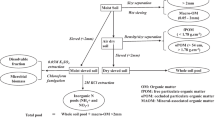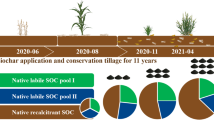Abstract
Biological nitrogen fixation (BNF) is a high energy-demanding process that may be inhibited by penguin guano. We tested this hypothesis in Ardley Island by measuring BNF in biological soil crusts (BSC) directly within a Penguin Colony and in sites unaffected by penguins. We also explored the effect of adding guano to BSCs in sites free of the influence of penguins. Water availability is also one of the most limiting elements for life in the Antarctica, and we expected that a wetter growing season would stimulate BNF. To evaluate the effect of moisture on BNF, we added water to BSCs under laboratory conditions and estimated BNF by means of the acetylene reduction assay during three growing seasons (2012, 2013 and 2014), with contrasting temperature and precipitation conditions. The results reveal an almost complete inhibition of N fixation in the BSCs of the Penguin Colony. In sites free of ammonium and phosphate in rainwater, BNF rates reached up to 3 kg N ha−1 year−1 during warmer and wetter years. The addition of guano to BSCs significantly inhibited the rates of BNF. In laboratory incubations, the addition of water significantly stimulated rates of BNF during the warmer growing season with more sunshine hours. The likely increases in soil moisture levels due to climate change and glacier melting in the Antarctic Peninsula may enhance the rates of BNF. However, this may be constrained by accompanying changes in the distribution of Penguin Colonies.






Similar content being viewed by others
References
Alcántara RJ, Centeno CM, Ponce A, Batista S, Merino M, Campo J, Falcón L (2014) Characterization and comparison of potential denitrifier in microbial mats from King George Island, maritime Antarctica. Polar Biol 37:403–416
Arróniz-Crespo M, Ortega S, De los Ríos A, Green A, Ochoa R, Casermeiro MA, De la Cruz MT, Pintado A, Palacios D, Rozzi R, Tysklind N, Sancho L (2014) Bryophyte-cyanobacteria associations during primary succession in recently deglaciated areas of Tierra del Fuego (Chile). PLoS One 5:e96081
Ball BA, Tellez CR, Virginia RA (2015) Penguin activity influences soil biogeochemistry and soil respiration in rookeries on Ross Island, Antarctica. Polar Biol 38:1357–1368
Belnap J (2001) Factors influencing nitrogen fixation and nitrogen release in biological soils crusts. In: Belnap J, Lange O (eds) Biological soil crusts: structure, function, and management. Ecological studies, vol 150. Springer, New York, pp 241–261
Beyer L, Pingpank K, Wriedt G (2000a) Soil formation in coastal continental Antarctica (Wilkes Land). Geoderma 95:283–304
Beyer L, Bölter M, Seppelt RD (2000b) Nutrient and thermal regime, microbial biomass, and vegetation of Antarctic soils in the Windmill Islands Region of east Antarctica (Wilkes Land). Arct Antarct Alp Res 32:30–39
Cannone N, Wagner D, Hubberten HW, Guglielmin M (2008) Biotic and abiotic factors influencing soil properties across a latitudinal gradient in Victoria Land, Antarctica. Geoderma 144:50–65
Chapin FS, Matson PA, Mooney HA (2002) Principles of terrestrial ecosystem ecology. Springer, New York
Cocks MP, Newton IP, Stock WD (1998) Bird effects on organic processes in soils from five microhabitats on a nunatak with and without breeding snow petrels in Dronning Maud Land, Antarctica. Polar Biol 20:112–120
Critteneden PD, Scrimgeour CM, Minnullina G, Sutton MA, Tang YS, Theobald MR (2015) Lichen response to ammonia deposition defines the footprint of a penguin rookery. Biogeochemistry 122:295–311
Ellbert W, Weber B, Burrows S, Steinkamp J, Büdel B, Andreae MO, Pöschl U (2012) Contribution of cryptogamic covers to the global cycles of carbon and nitrogen. Nat Geosci 5:451–462
Erskine PD, Bergstrom DM, Schmidt S, Stewart GR, Tweedie CE, Shaw JD (1998) Subantarctic Macquarie Island- a model ecosystem for studying animal-derived nitrogen sources using 15N natural abundance. Oecologia 117:187–193
Fretwell PT, Hodgson DA, Watcham EP, Bentley MJ, Roberts SJ (2010) Holocene isostatic uplift of the South Shetland Islands, Antarctic Peninsula, modelled from raised beaches. Quat Sci Rev 29:1880–1893
Groffman PM, Holland EA, Myrold DD, Robertson GP, Zou X (1999) Denitrification. In: Robertson GP, Coleman DC, Bledsoe CS, Sollins P (eds) Standard soil methods for long term ecological research. Oxford University Press, New York, pp 241–257
Hardy RWF, Holsten RD, Jackson EK, Burns RC (1968) The acetylene-ethylene assay for N2-fixation: laboratory and field evaluation. Plant Physiol 43:1185–1207
Hobara S, McCalley C, Koba K, Giblin AE, Weiss MS, Gettel GM, Shaver GR (2006) Nitrogen fixation in surface soils and vegetation in an Arctic Tundra watershed: a key source of atmospheric nitrogen. Arct Antarct Alp Res 38:363–372
Johnston CG, Vestal JR (1991) Photosynthetic carbon incorporation and turnover in the Antarctic cryptoendolithic microbial communities: are they the slowest-growing communities on earth? Appl Environ Microbiol 57:2308–2311
Jones AE, Weller R, Wolff EW, Jacobi HW (2000) Speciation and rate of photochemical NO and NO2 production in Antarctic Snow. Geophys Res Lett 27:345–348
Jung J, Furutani Uematsu M (2011) Atmospheric inorganic nitrogen aerosol and precipitation and its deposition to the North and South Pacific Oceans. J Atmos Chem 68:157–181
Li F, Ramaswamy V, Ginoux P, Broccoli AJ, Delworth T (2010) Toward understanding the dust deposition in Antarctica during last glacial maximum: sensitivity studies on plausible causes. J Geophys Res 115:D 24120
Lindeboom HJ (1984) The nitrogen pathway in a penguin rookery. Ecology 65:269–277
Michel RFM, Schaefer CE, Simas FNB, Barbosa DSA, Oliveira SA (2010) Ornithogenic cryosols from Ardley Island, Maritime Antarctica. In: 19th world congress of soil science, Brisbane, Australia, pp 39–42
Myrold DD, Ruess RR, Klug MJ (1999) Dinitrogen fixation. In: Robertson GP, Coleman DC, Bledsoe CS, Sollins P (eds) Standard Soil methods for long term ecological research. Oxford University Press, New York, pp 241–257
Paerl HW, Priscu JC (1998) Microbial phototrophic, heterotrophic, and diazotrophic activities associated with aggregates in the permanent ice cover of Lake Bonney, Antarctica. Microb Ecol 36:221–230
Pérez CA, Hedin LO, Armesto JJ (1998) Nitrogen mineralization in two unpolluted old-growth forests of contrasting biodiversity and dynamics. Ecosystems 1:361–373
Pérez CA, Aravena JC, Silva WA, Henríquez JM, Fariña JM, Armesto JJ (2014) Ecosystem development in short-term postglacial chronosequences: N and P limitation in glacier forelands from Santa Inés Island, Magellan Strait. Austral Ecol 39:288–303
Peter H-U, Buesser C, Mustafa O, Pfeiffer S (2008) Risk assessment for the Fildes Peninsula and Ardley Island and the development of management plans for designation as Antarctic specially protected or managed areas. Fed Environ Agency Texte 20(8):508
Reed SC, Cleveland CC, Townsend AR (2011) Functional ecology of free-living nitrogen fixation: a contemporary perspective. Annu Rev Ecol Syst 42:489–512
Robinson SA, Wasley J, Tobin AK (2003) Living on the edge-plants and global change in continental and maritime Antarctica. Glob Change Biol 9:1681–1717
Savarino J, Kaiser J, Morin S, Sigman DM, Thiemens MH (2007) Nitrogen and oxygen isotopic constraints on the origin of atmospheric nitrate in coastal Antarctica. Atmos Chem Phys 7:1925–1945
Simas FNB, Schaefer CEGR, de Melo VF, Albuquerque MR, Michel RFM, Pereira VV, Gomes MRM, Costa LM (2007) Ornithogenic cryosols from maritime Antarctica: phosphatization as a soil forming process. Geoderma 138:191–203
Sorensen PL, Jonasson S, Michelsen A (2006) Nitrogen fixation, denitrification, and ecosystem nitrogen pools in relation to vegetation development in the Subarctic. Arct Antarct Alp Res 38:263–272
Steubing L, Fangmeier A (1992) Pflanzenökologisches Praktikum. Ulmer, Stuttgart
Stewart KJ, Coxson D, Grogan P (2011) Nitrogen inputs by associative cyanobacteria across low arctic tundra landscape. Arct Antarct Alp Res 43:267–278
Strauss SL, Garcia-Pichel F (2012) Soil microbial carbon and nitrogen transformations at a glacial foreland on Anvers Island, Antarctic Peninsula. Polar Biol 35:1459–1471
Strauss SL, Ruhland CT, Day T (2009) Trends in soil characteristics along a recently deglaciated foreland on Anvers Island, Antarctic Peninsula. Polar Biol 32:1779–1788
Sun L, Zhu R, Xie Z, Xing G (2002) Emissions of nitrous oxide and methane from Antarctic Tundra: role of penguin dropping deposition. Atmos Environ 36:4977–4982
Tatur A (2002) Ornithogenic ecosystems in the maritime antarctic-formation, development and desintegration. In: Beyer L, Bölter M (eds) Geoecology of Antarctic ice-free coastal landscapes. Ecological studies, vol 154. Springer, New York, pp 161–186
Tscherko D, Bölter M, Beyer L, Chen J, Elster J, Kandeler E, Khun E, Blume HP (2003) Biomass and enzyme activity of two soils transects at King George Island, maritime Antarctica. Arct Antarct Alp Res 35:34–47
Vaughan DG (2006) Recent trends in melting conditions on the Antarctic Peninsula and their implications for ice-sheet mass balance and sea level. Arct Antarct Alp Res 38:147–152
Vincent WF (2000) Cyanobacterial dominance in polar regions. In: Whitton BA, Potts M (eds) The ecology of cyanobacteria. Kluwer, Dordrecht, pp 321–340
Wagenbach D, Legrand M, Fischer H, Pichlmayer F, Wolff EW (1998) Atmospheric near-surface nitrate at coastal Antarctic sites. J Geophys Res 103:11007–11020
Wang NF, Zhang T, Zhang F, Wang ET, He JF, Ding H, Zhang BT, Liu J, Ran XB, Zang JY (2015) Diversity and structure of soil bacterial communities in the Fildes Region (maritime Antarctica) as revealed by 454 pyrosequencing. Front Microbiol 6:1188
Wasley J, Robinson S, Lovelock C, Popp M (2006) Climate change manipulations show Antarctic flora is more strongly affected by elevated nutrients than water. Glob Change Biol 12:1800–1812
Zhu R, Liu Y, Li X, Sun J, Xu H, Sun L (2008) Stable isotope natural abundance of nitrous oxide emitted from Antarctic tundra soils: effects of sea animal excrements depositions. Rapid Commun Mass Spectrom 22:3570–3578
Zhu R, Wang Q, Ding W, Wang C, Hou L, Ma D (2014) Penguins significantly increased phosphine formation and phosphorus contribution in maritime Antarctic soils. Nat Sci Rep 4:7055
Zielke M, Solheim B, Spjelkavit S, Olsen R (2005) Nitrogen fixation in the high Arctic: role of vegetation and environmental conditions. Arct Antarct Alp Res 37:372–378
Zuberer DA (1998) Biological dinitrogen fixation: introduction and nonsymbiotic. In: Sylvia DM, Fuhrmann JJ, Hartel PG, Zuberer DA (eds) Principles and applications of soil microbiology. Prentice Hall, Upper Saddle River, pp 295–321
Acknowledgments
This research was funded by the projects INACH T01-11 and Fondecyt 1130353. We are grateful to Claudia Mansilla and Carla Henriquez for their help in the field and INACH for logistic support. International travel for R. McCulloch and C. Mansilla was funded by the University of Stirling. We are also grateful to three anonymous reviewers that greatly helped to improve the first version of the manuscript.
Author information
Authors and Affiliations
Corresponding author
Rights and permissions
About this article
Cite this article
Pérez, C.A., Aravena, J.C., Ivanovich, C. et al. Effects of penguin guano and moisture on nitrogen biological fixation in maritime Antarctic soils. Polar Biol 40, 437–448 (2017). https://doi.org/10.1007/s00300-016-1971-5
Received:
Revised:
Accepted:
Published:
Issue Date:
DOI: https://doi.org/10.1007/s00300-016-1971-5




